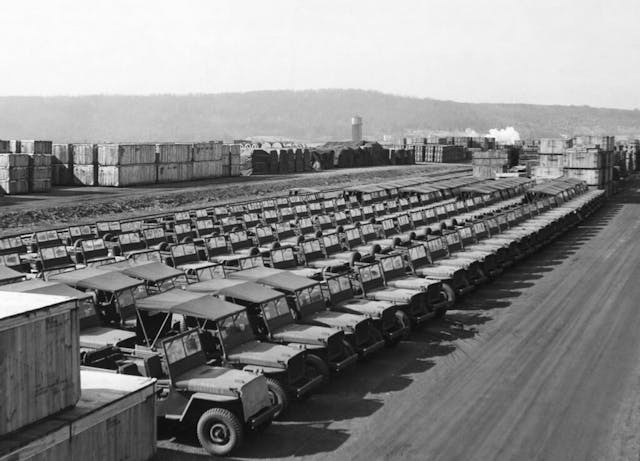Happy Veterans Day to the Willys-Overland Jeep
A “jeep” didn’t always mean a cult-favorite off-roader closely associated with rubber ducks or spare tire covers with flower decals. No, the first jeeps were the U.S. Army’s solution to riding on horseback. (Yes, really.) On this Veteran’s Day, we salute the O.G. jeep: The quarter-ton 4×4 designed and built, in large part, by Willys-Overland of Toledo, Ohio.
Turns out those Ohioans were strategic fellows. Though Willys design had won the government contract, the Army also handed the plans to Ford—they needed a lot of jeeps, and they needed them fast. Ford called its truck the GP, for General Purpose (or for “Government” and its 80-inch wheelbase, depending on who you ask), and Willys called its truck the MB. Not only did the folks in Toledo manage to build the lion’s share of the vehicles—647,870 during WWII—but they trademarked “jeep,” essentially a slang way of pronouncing “GP” as one word. As of July, 1945, Willys began to sell its jeeps to the public.

We have celebrated the early jeeps at length: We took a 1944 MB to Normandy on the 75th anniversary of D-day, we have shared the struggles of getting a CJ-2A back on the road, and even dubbed the CJ the greatest vehicle of the 1940s. And that’s just coverage of the early ones! You can traverse our wealth of Jeep content by clicking here, but today, join us for a visual jaunt through the early days of the civilian jeep. And remember, the air-conditioned, hard-top, cloth-upholstered Wranglers of today wouldn’t exist without this flat-fender, canvas-topped veteran.

When the first civilian jeep (known as the CJ-2A) went on sale on July 17, 1945, Willys-Overland leaned heavily on its usefulness. Few vehicles since the Model T, surely, were volunteered for so many different uses! A ‘Jeep’ could power an air compressor, haul up to 800 pounds, pull a plow or a mower, or scramble to a remote campsite.

A farmer might need some extra kit to get the most out of their ‘Jeep’, as Willys-Overland advertised in Farm Journal. Factory off-roading accessories, broadly defined, have been available since Day 1!

Oh, and the 60-hp Go Devil engine was fuel-efficient as well. These were the war years, and belts were tight. Check out this ad from the July, 1946 issue of Time magazine:

The jeep was, in fact, remarkably similar to the 600,000+ units that Ford and Willys-Overland shipped overseas. P.J. O’Rourke summarizes the changes from the military to the civilian model: “It was out of uniform, but barely. The CJ2A had larger headlights, softer springs, taller gearing, a tailgate and more comfortable seats. It came in pretty colors, too, all for $1,090.”
It didn’t take long after the war for Willys-Overland to discover that its customers—though they adored the go-anywhere, do-anything persona of the jeep—didn’t spend as much time going anywhere and doing anything as the automaker, or buyers themselves, had expected. In 1948 the CJ-2A was succeeded by the CJ-3A (though the 2A would be built for another two years), which had … a one-piece windshield!

The Jeep only continued to adjust to civilian life. In 1953, the year that Kaiser bought Willys, the CJ3B model was rolled out, with 15 more hp courtesy of an F-head “Hurricane” engine. As of 1955, you could even order a Jeep with a cab, made of steel.
That CJ-3B would remain in production until 1964. Again, the “generations” overlap: In 1954, the CJ-5 appeared, with a stronger chassis, smoother contours, and an increase in length and in width. When it finally went out of production in 1983—years after American Motors took over production—the CJ-5 boasted the longest production run of any American vehicle.
As those resourceful folks at Willys would undoubtedly love to remind Ford, its 4×4 had remained in production longer than the Model T. What an abundant legacy!




Don’t forget the original jeep was the BRC Bantan Reconnaissance Car, built by the Bantam Car Company, Butler PA in 1940…
.
Out of all the Jeeps I’ve had over the past 50 years, my ’61 CJ3B is my favorite. It was only slightly more “civilized” than a military vehicle, but enough so that I felt like I shouldn’t paint it OD. I really let it go too easily, only to regret it nearly every day for the last 30 years!